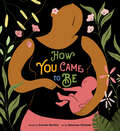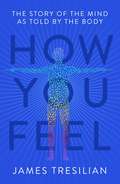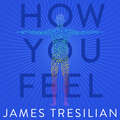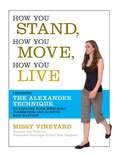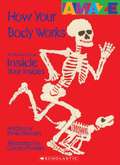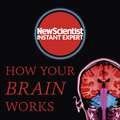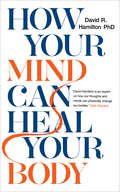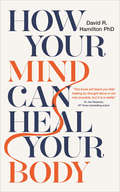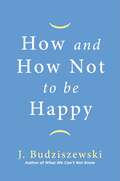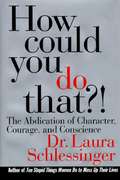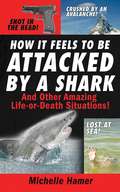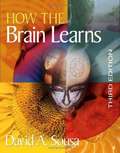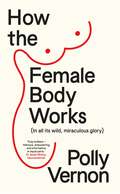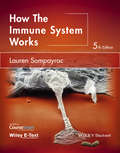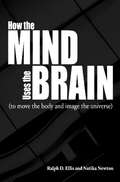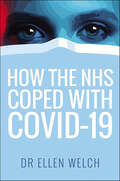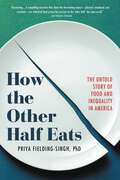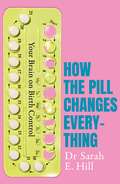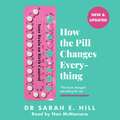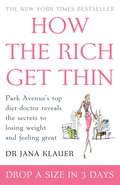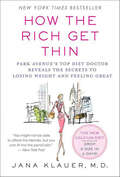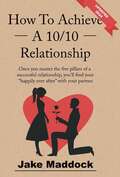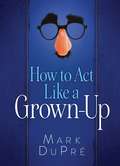- Table View
- List View
How You Came to Be
by Carole GerberThis love letter written from mother to child invites readers to experience a baby's month-by-month development in the womb as compared to familiar fruits and vegetables.A mother lovingly describes the sizes and stages of her baby's month-by-month development inside the womb, and the amazement of experiencing it from the outside. Look at you - as big as a banana! Some of your cells formed into bones,and your arms and legs grew longer.I could feel you kick!Sometimes when I rubbed my belly,I felt you thump back. Was that your way of saying hello?Simple, age-appropriate facts are woven into a tender and lyrical text that celebrates the miracle of a baby. It demystifies and informs readers, while simultaneously appreciating the wonder of it all. A perfect read-aloud for mother and child, or for children whose mothers are pregnant with a younger sibling.
How You Feel: The Story of the Mind as Told by the Body
by James TresilianClose your eyes and ask yourself, 'what do I feel?'You might feel thirsty or tired. You might feel healthy and well or perhaps a little under the weather. Maybe you can feel that you are standing or that you are leaning over. You may also feel the world around you - the shape and texture of an apple in your hand, the feel of a chair you're sitting on.All these feelings have something in common, say psychologists and neuroscientists. They are all mental events, things that happen in the mind. But what if this is all wrong?What if it's not just the mind, but also the body itself that feels? And not merely physical sensations, but other feelings that seem to have nothing to do with bodies. Things like 'emotions' and 'intuitions' - joy or rage, anxiety or optimism, or the feeling of being hard done by or misunderstood?Drawing on the latest research and a range of classic and contemporary thought, How You Feel shows you that your brain and your body are two parts of a single system that creates your mind and mental life. You will discover that you don't have feelings, thoughts and emotions inside your body, you have them with your body. There can be no mind without the body.Psychology is no longer about the brain, or about 'mind and body', it is about the whole that is you.
How You Feel: The Story of the Mind as Told by the Body
by James TresilianClose your eyes and ask yourself, ''what do I feel?''You might feel thirsty or tired. You might feel healthy and well or perhaps a little under the weather. Maybe you can feel that you are standing or that you are leaning over. You may also feel the world around you - the shape and texture of an apple in your hand, the feel of a chair you''re sitting on.All these feelings have something in common, say psychologists and neuroscientists. They are all mental events, things that happen in the mind. But what if this is all wrong?What if it''s not just the mind, but also the body itself that feels? And not merely physical sensations, but other feelings that seem to have nothing to do with bodies. Things like ''emotions'' and ''intuitions'' - joy or rage, anxiety or optimism, or the feeling of being hard done by or misunderstood?Drawing on the latest research and a range of classic and contemporary thought, How You Feel shows you that your brain and your body are two parts of a single system that creates your mind and mental life. You will discover that you don''t have feelings, thoughts and emotions inside your body, you have them with your body. There can be no mind without the body.Psychology is no longer about the brain, or about ''mind and body'', it is about the whole that is you.
How You Feel: The Story of the Mind as Told by the Body
by James TresilianClose your eyes and ask yourself, 'what do I feel?'You might feel thirsty or tired. You might feel healthy and well or perhaps a little under the weather. Maybe you can feel that you are standing or that you are leaning over. You may also feel the world around you - the shape and texture of an apple in your hand, the feel of a chair you're sitting on.All these feelings have something in common, say psychologists and neuroscientists. They are all mental events, things that happen in the mind. But what if this is all wrong?What if it's not just the mind, but also the body itself that feels? And not merely physical sensations, but other feelings that seem to have nothing to do with bodies. Things like 'emotions' and 'intuitions' - joy or rage, anxiety or optimism, or the feeling of being hard done by or misunderstood?Drawing on the latest research and a range of classic and contemporary thought, How You Feel shows you that your brain and your body are two parts of a single system that creates your mind and mental life. You will discover that you don't have feelings, thoughts and emotions inside your body, you have them with your body. There can be no mind without the body.Psychology is no longer about the brain, or about 'mind and body', it is about the whole that is you.
How You Stand, How You Move, How You Live: Learning the Alexander Technique to Explore Your Mind-Body Connection and Achieve Self-Mastery
by Missy Vineyard Illustrations by Matthew MitchellA comprehensive new guide to The Alexander Technique: A simple yet powerful method for improving how the mind and body interact
How Your Body Works: A Good Look Inside Your Insides
by David StewartWhat, Why, and How is explained with respect to human body.
How Your Brain Works: Inside the most complicated object in the known universe (New Scientist Instant Expert)
by New ScientistIn How Your Brain Works leading neuroscientists and New Scientist introduce the evolution and anatomy of the brain viewed through traits such as: memory, emotions, sleep, sensing and perception.Ever wondered what's going on inside your head?You are your brain. Everything that makes you you, and all your experiences of the world, are somehow conjured up by 1.4 kilograms of grey matter inside your skull. That might seem impossible, but science has advanced so much that we now understand not just its structures and inner workings but also how it can give rise to perception, consciousness, emotions, memories, intelligence, sleep and more. HOW YOUR BRAIN WORKS explores the amazing world inside your head. Discover the evolution and anatomy of the brain. Learn how we can peer inside it and watch it at work, and how the latest technology can allow us to control our minds and those of others. ABOUT THE SERIESNew Scientist Instant Expert books are definitive and accessible entry points to the most important subjects in science; subjects that challenge, attract debate, invite controversy and engage the most enquiring minds. Designed for curious readers who want to know how things work and why, the Instant Expert series explores the topics that really matter and their impact on individuals, society, and the planet, translating the scientific complexities around us into language that's open to everyone, and putting new ideas and discoveries into perspective and context.(P) 2017 Hodder & Stoughton Limited
How Your Mind Can Heal Your Body: 10th Anniversary Edition
by David R. HamiltonThe connection between your mind and body is close, powerful, and often a valuable tool in taking control of your life and ambitions. The power of thought can affect you in profound ways, particularly in regards to its truly incredible effect on your health, explored in detail within these pages. This fascinating book by cutting-edge scientist David R. Hamilton explores the power of visualization, belief, and positive thinking —and their effects on the body. He also presents a revolutionary quantum-field healing meditation —through which you can change yourself on an atomic level —and shows you how you can use your imagination and thought processes to combat disease, pain, and illness. You will see how science and belief systems can merge . . . so that you can heal yourself more effectively than ever before!
How Your Mind Can Heal Your Body: 10th-Anniversary Edition
by David R. Hamilton&‘This book will teach you that healing by thought alone is not only possible, but it is a reality.&’ - Dr Joe Dispenza, New York Times bestselling author of Becoming SupernaturalThere is no longer any doubt that the way we think affects our bodies: countless scientific studies have shown this to be true. For former pharmaceutical scientist Dr David Hamilton, the testing of new drugs highlighted how profoundly the mind and body are connected. Time and time again, the control group of patients in drug trials improved at similar rates to those who actually received the medicines. Astounded, Dr Hamilton decided to change the direction of his work to explore the relationship between the mind and the body.This bestselling acclaimed book was first published 10 years ago. In it, Dr Hamilton explores the effect of visualization, belief and positive thinking on the body, and shows how using our imagination and mental processes can stimulate our own defences and healing systems to combat disease, pain and illness.In this new edition, Dr Hamilton has added four new chapters to discuss the latest cutting-edge information and extraordinary new techniques. These include using imagery to stimulate the immune system - a method that can benefit cancer patients undergoing conventional treatment - effectively using the mind to speed up rehabilitation from stroke, and powerful visualization strategies to help facilitate recovery from injury and illness.
How and How Not to Be Happy
by J. BudziszewskiIt&’s Time to Start Asking the Right Questions About Happiness The West is facing a happiness crisis. Today, less than a quarter of American adults rate themselves as very happy—a record low. False views of happiness abound, and the explosion in &“happiness studies&” has done little to dispel them. Why is true happiness so elusive, and why is it so hard to define? In How and How Not to Be Happy, internationally renowned philosopher and happiness theorist, J. Budziszewski, draws on decades of study to dispel the myths and wishful thinking that blind people from uncovering lasting fulfillment. Could happiness lie in health, wealth, responsibility, or pleasure? Should we settle for imperfect happiness? What would it even mean to attain perfect fulfillment? Budziszewski separates the wheat from the chaff, exploring how to attain happiness—and just as importantly, how not to.
How and When to Be Your Own Doctor
by Isabelle A. Moser Steve SolomonDr. Isabelle A. Moser and Steve Solomon collaborated on How and When to Be Your Own Doctor. When Solomon reached his late thirties, he began looking for healthy alternatives. He met Moser and began the practice of a yearly fast to cleanse his body. This book contains their combined knowledge on healing. Topics include How I Became a Hygienist, The Nature and Cause of Disease, Fasting, Colon Cleansing, Diet and Nutrition, Vitamins and Other Food Supplements and The Analysis of Disease States--Helping the Body Recover.
How could you do that?!: The Abdication of Character, Courage, and Conscience
by Laura SchlessingerDr. Laura Schlessinger--the internationally syndicated radio superhost shows both men and women how honoring our personal values--or doing good--leads to feeling great.
How it Feels to Be Attcked by a Shark: And Other Amazing Life-or-death Situations!
by Michelle HamerWhat does it feel like to find yourself in the grip of a 15-foot Great White shark? To be struck not once but twice by lightning? Here are 40 incredible true-life stories of people who lived through the most harrowing experiences you could imagine. In some cases, they stared death right in the face; in others, they wished they could die but somehow found the strength to go on. A remarkable group of survivors explain, in their own words, what it's like to get shot in the head, brainwashed by a cult, buried by an avalanche, attacked by a crocodile, and much more. What they have to say will surprise and enlighten, and certainly satisfy our curiosity about what it means to go to the very edge...and come back.
How the Brain Learns (3rd Edition)
by David A. SousaThe new, Third Edition of How the Brain Learns continues to focus on helping educators turn research on brain functioning into practical classroom strategies. This revised edition includes information on how the brain processes information and how this helps students learn, tips on maximizing student retention using "down time," and such familiar pedagogy from previous editions as the Practitioner's Corner, Key Points to Ponder, and pre- and post-assessments to measure the reader's knowledge. New to the third edition is: Updated information on the Information Processing Model to reflect newer terminology and understandings about memory systems Updated and exciting new research about language acquisition and how the brain learns to read An expanded chapter on thinking skills including the recently revised version of Bloom's Taxonomy More examples of how emotions influence learning and memory New Practitioner's Corners An updated resource section that includes additional books and Internet sites More primary sources for those who wish to review the actual research studies
How the Female Body Works: (In all its wild, miraculous glory)
by Polly Vernon"Witty and wise - How the Female Body Works is a wonderful blend of science and humour. I laughed, I learned, and I felt seen. A must-read for anyone in a female body - and anyone who knows one." - Dr Charlotte Gribbin, Consultant Aesthetic & Regenerative Medicine Physician'Technically, we're close, my body and I. We go everywhere together. And yet, I know little about how it actually works...'How much do any of us really know about our bodies? We know, for example, that women live longer than men, but why? We are told our brains are better at multi-tasking, but is that true? What exactly are hormones? Like: what do they look like? What's the point of PMS? Why are women twice as likely as men to develop Alzheimer's? And what's the deal with things like osteoporosis - why are our bones so damn fragile?For years, award-winning journalist Polly Vernon drove her body around like it was a car - and she had zero interest in the manual. This book charts her mission to lift the bonnet, have a good old rummage and find out what's really going on. She talks to neuroscientists, academics, medics, midwives, gynaes, psychologists and physios. People who really know their stuff.And so here it is, THE complete guide to the female body - head to toe, inside and out, physical and emotional - with reassuring advice on how to mitigate the ways it makes life trickier, along with notes of celebration for the ways it helps us out.Full of facts and stories that will blow your mind, this is a book you'll want to pass on to every woman (and man) you know.
How the Immune System Works
by Lauren M. SompayracHow the Immune System Works is not a comprehensive textbook. It's the book thousands of students have used to help them understand what's in their big, thick, immunology texts. In this book, Dr. Sompayrac cuts through the jargon and details to reveal, in simple language, the essence of this complex subject. Fifteen easy to follow lectures, featuring the uniquely popular humorous style and engaging analogies developed by Dr Sompayrac, provide an introduction to the 'bigger picture', followed by practical discussion on how each of the components interacts with one another. Now featuring full-color diagrams, this book has been rigorously updated for its fourth edition to reflect today's immunology teaching and includes updated discussion of B and T cell memory, T cell activation, vaccines, immunodeficiency, and cancer. Whether you are completely new to immunology, or require a refresher, How the Immune System Works is an enjoyable way of engaging with the key concepts - you need know nothing of the workings of the immune system to benefit from this book! How the Immune System Works is now accompanied by a FREE enhanced Wiley Desktop Edition - the interactive, digital version of the book - featuring downloadable text and images, highlighting and note taking facilities, book-marking, cross-referencing, in-text searching, and linking to references and glossary terms. It is also available from CourseSmart for instant, online and offline access for studying anytime, anywhere.
How the Mind Uses the Brain
by Natika Newton Ralph EllisThe nature of consciousness and the relationship between the mind and brain have become the most hotly debated topics in philosophy. This book explains and argues for a new approach called enactivism. Enactivism maintains that consciousness and all subjective thoughts and feelings arise from an organism's attempts to use its environment in the service of purposeful action. The authors admit that their perspective presents many problems: How does one distinguish real action from reaction? Is it scientifically acceptable to say that the whole organism can use its parts, instead of being a mere summation of their separate mechanical reactions? What about the danger that this analysis will imply that physical systems fail to be "causally closed"? How the Mind Uses the Brain tries to answer these questions and represents a sharp break with tradition, arguing that consciousness and emotions are aspects of an organism's ongoing self-organizational activity, driving information-processing rather than merely responding to it.
How the NHS Coped with Covid-19
by Ellen Welch2020 will forever be remembered as the year the Coronavirus pandemic changed life as we know it across the World. Economies crashed, livelihoods were eradicated, and thousands of lives were shortened or devastated by the effects of this novel virus. In the UK, the National Health Service was thrust into the limelight as the country watched our healthcare system respond to the consequences of this disease. This book traces a timeline of the COVID-19 pandemic, highlighting key events in how the UK and the NHS approached these unparalleled events. Comparisons are made with tactics used around the globe and the decisions of our leaders questioned. Alongside the facts, are stories. Every one of us has a ‘Covid story’ to tell, and this book is a collection of some of these stories from our frontline staff. As the country went into rapid lockdown in March, the staff of the NHS donned their PPE and continued to go to work. They tell us what peak pandemic was like in the emergency departments, wards, ICUs, GP practices, care homes and the ambulances of the UK. We hear from a nurse who became a covid patient in her own ICU; staff from the rapidly constructed Nightingale hospital; a GP who returned from retirement to assist with the response; as well as stories from international healthcare professionals such a as a cruise ship nurse in the Caribbean, a public health consultant in Australia and ED doctors in South Africa.
How the Other Half Eats: The Untold Story of Food and Inequality in America
by Priya Fielding-SinghA &“deeply empathetic&” (Publishers Weekly, starred review) &“must-read&” (Marion Nestle) that &“weaves lyrical storytelling and fascinating research into a compelling narrative&” (Chronicle Review) to look at dietary differences along class lines and nutritional disparities in America, illuminating exactly how inequality starts on the dinner plate.Inequality in America manifests in many ways, but perhaps nowhere more than in how we eat. From her years of field research, sociologist and ethnographer Priya Fielding-Singh brings us into the kitchens of dozens of families from varied educational, economic, and ethnoracial backgrounds to explore how—and why—we eat the way we do. We get to know four families intimately: the Bakers, a Black family living below the federal poverty line; the Williamses, a working-class white family just above it; the Ortegas, a middle-class Latinx family; and the Cains, an affluent white family.Whether it's worrying about how far pantry provisions can stretch or whether there's enough time to get dinner on the table before soccer practice, all families have unique experiences that reveal their particular dietary constraints and challenges. By diving into the nuances of these families&’ lives, Fielding-Singh lays bare the limits of efforts narrowly focused on improving families&’ food access. Instead, she reveals how being rich or poor in America impacts something even more fundamental than the food families can afford: these experiences impact the very meaning of food itself.Packed with lyrical storytelling and groundbreaking research, as well as Fielding-Singh&’s personal experiences with food as a biracial, South Asian American woman, How the Other Half Eats illuminates exactly how inequality starts on the dinner plate. Once you&’ve taken a seat at tables across America, you&’ll never think about class, food, and public health the same way again.
How the Pill Changes Everything: Your Brain on Birth Control
by Sarah E HillTHE PILLChanges your brainAlters your stress responseCan increase your risk of depressionAffects your choice of mate selectionHormonal birth control is taken by millions of women around the world every day. Yet until recently we knew very little about how the Pill affects the non-reproductive systems of the female body, because research on these other systems was conducted almost exclusively on men. In her trailblazing book, Dr Sarah Hill uses the latest science to reveal how the Pill is changing women and the world, for better and worse. She puts the power back in your hands to make smarter, more informed choices about your health and your hormones.IT'S EVERYTHING YOUR DOCTOR NEVER TOLD YOU
How the Pill Changes Everything: Your Brain on Birth Control
by Sarah E Hill'It's time for all of us to join together to ask science for some new choices and for more information about what happens to us with the choices we have. We shouldn't have to change who we are to protect ourselves from pregnancy, and we should know enough about how our own bodies work to recognize that this is exactly what we're doing when we go on the birth control pill' Hormonal contraception is something most women will use at some point during their life. But the reach of the pill goes far beyond the small number of targeted effects we take it for. It affects almost every system in our body.Column inches and anecdotal conversations prove there are many questions about the pill and its effects yet until now we have known very little about. In this trailblazing book expert psychologist Dr Hill reveals the latest science on the pill, and how it's changing women and the world, for better and for worse. Dr Hill examines cutting-edge research, some of it conducted in her own lab, that shows how the pill affects everything from stress response to autoimmune disorders, mate selection to declining levels of male achievement. Some of her findings are shocking, others will simply verify things you suspected for a long time, but figured were all in your head. Dr Hill signals a rallying cry for better science - for too long women have been understudied as research subjects. Their cycles are more complicated, it's more expensive to do research on them, and scientists are under so much pressure to publish that it's often easier to just use a largely male testing pool, or one that ignores important factors for women. This is your Brain on Birth Control will open your eyes and put you in a position of power. It provides the latest science so that you can understand the risks, weigh up the costs and make smarter, more informed choices about your health and hormones.
How the Rich Get Thin: Park Avenue's Top Diet Doctor Reveals The Secrets To Losing Weight And Feeling Great
by Dr Jana KlauerNew York's top weight-control doctor finally reveals the secrets to the enviably lean bodies leaving her Park Avenue offices. Based on science and proved by the success of client after client, Dr Jana Klauer's diet is the key to how successful, rich and busy modern men and women get weight off and keep it off. How the Rich Get Thin features wonderful recipes, including the low-cal desert Le Socia-Lite. Begin with Dr Klauer's Non-negotiables - including 'Say yes to complex carbohydrates' and 'Get lots of calcium from dairy products' - and add a simple mind-set change to control those cravings, and watch yourself lose that weight!
How the Rich Get Thin: Park Avenue's Top Diet Doctor Reveals the Secrets to Losing Weight and Feeling Great
by Jana KlauerYou know the ones: the women walking down Park or Fifth Avenues on Manhattan's Upper East Side. Hermes handbag on the arm. Hair just so. Sleek and groomed as greyhounds. How The Rich Get Thin, from one of New York's premier weight control doctors, reveals the secrets of how the successful and rich get and stay thin. With a quick-start two week program that the dieter later builds on to keep losing weight and eventually to maintain their shape, How The Rich Get Thin includes:--Meal plans high in protein, omega-3 fats and complex carbohydrates--Calcium, through food rather than supplements, in the maximum amount the body can absorb at a time--A morning exercise program as an adjunct to eating--The Stop Watch method to curb food cravings: any craving can be stopped within just 15 minutes--How to eat at fabulous restaurants, for business or pleasure, and keep losing weight.
How to Achieve a 10/10 Relationship
by Jake MaddockHow to achieve a 10/10 relationship, this book is exactly what it sounds like, I'm a relationship coach who has coached thousands of people over the years. My goal in life is to help as many people as possible achieve a 10/10. This will help you achieve a 10/10 with your ideal partner. Carefully study the book and try to read it at least 10 times.
How to Act Like a Grown-up
by Mark DupréFilled with a mountain of practical advice, enjoy this timeless collection of grown-up perspectives that many never get to hear on their way to twenty-one. With humor and occasional bite, How to Act Like a Grown-Up is an indispensable guide for moving into adulthood. Mark addresses thirty topics including cell phone etiquette, clothing, driving, finishing what you start, going to class, meeting people, money, sexuality, voting, and much more. Don't learn these lessons the hard way. Enjoy a humorous and educational ride as you grow up into acting like a grown-up.
